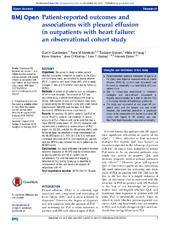| dc.contributor.author | Gundersen, Guri Holmen | en_US |
| dc.contributor.author | Norekvål, Tone M. | en_US |
| dc.contributor.author | Graven, Torbjørn | en_US |
| dc.contributor.author | Haug, Hilde Haugberg | en_US |
| dc.contributor.author | Skjetne, Kyrre | en_US |
| dc.contributor.author | Kleinau, Jens Olaf | en_US |
| dc.contributor.author | Gustad, Lise | en_US |
| dc.contributor.author | Dalen, Håvard | en_US |
| dc.date.accessioned | 2018-04-25T10:42:58Z | |
| dc.date.available | 2018-04-25T10:42:58Z | |
| dc.date.issued | 2017 | |
| dc.Published | Gundersen GH, Norekvål TM, Graven T, Haug HH, Skjetne K, Kleinau JO, Gustad LT, Dalen HD. Patient-reported outcomes and associations with pleural effusion in outpatients with heart failure: an observational cohort study. BMJ Open. 2017;7:e013734 | eng |
| dc.identifier.issn | 2044-6055 | |
| dc.identifier.uri | https://hdl.handle.net/1956/17652 | |
| dc.description.abstract | Objectives: We aimed to study whether patient-reported outcomes, measured by quality of life (QoL) and functional class, are sensitive to pleural effusion (PLE) in patients with heart failure (HF), and to study changes in QoL and functional class during follow-up of PLE. Methods: A cohort of 62 patients from an outpatient HF clinic was included. The amount of PLE was quantified using a pocket-sized ultrasound imaging device. Self-reports of QoL and functional class were collected using the Minnesota Living with Heart Failure Questionnaire (MLHFQ) and the New York Heart Association (NYHA) functional classification. Results: At baseline, 26 (42%) patients had PLE of which 19 (31%) patients had moderate to severe amounts of PLE. Patients with no to mild PLE had a lower MLHFQ score (mean 42, SD 21) compared with patients with a moderate to severe amount of PLE (mean 55, SD 24), p=0.03. For 28 patients (45%) with follow-up data, we observed a linear improvement of the MLHFQ-score (3.2, 95% CI 1.2 to 5.1) with each centimetre reduction of PLE. Correspondingly, patient-reported NYHA-class followed the same pattern as the MLHFQ-score. Conclusions: Our study indicates that patient-reported outcome measures as MLHFQ may be sensitive tools to identify patients with HF at highest risk of symptomatic PLE and that treatment targeting reduction of PLE during follow-up is essential to improvement of QoL and functional capacity of outpatients with HF. | en_US |
| dc.language.iso | eng | eng |
| dc.publisher | BMJ | eng |
| dc.relation.uri | http://bmjopen.bmj.com/content/7/3/e013734 | |
| dc.rights | Attribution CC BY-NC | eng |
| dc.rights.uri | http://creativecommons.org/licenses/by-nc/4.0/ | eng |
| dc.title | Patient-reported outcomes and associations with pleural effusion in outpatients with heart failure: an observational cohort study | en_US |
| dc.type | Peer reviewed | |
| dc.type | Journal article | |
| dc.date.updated | 2017-12-29T11:51:10Z | |
| dc.description.version | publishedVersion | en_US |
| dc.rights.holder | Copyright 2017 The Author(s) | |
| dc.identifier.doi | https://doi.org/10.1136/bmjopen-2016-013734 | |
| dc.identifier.cristin | 1460389 | |
| dc.source.journal | BMJ Open | |
| dc.relation.project | Norges forskningsråd: 237887 | |

